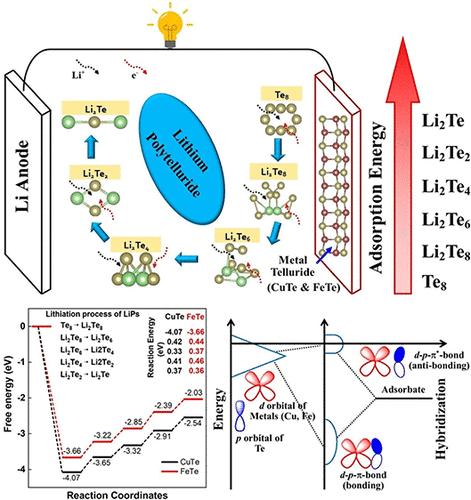金属碲化物作为高能锂碲电池正极材料的研究
IF 8.2
2区 材料科学
Q1 MATERIALS SCIENCE, MULTIDISCIPLINARY
引用次数: 0
摘要
与硫和硒相比,锂碲(Li-Te)电池具有优越的导电性和高容量,因此作为下一代储能系统备受关注。碲的独特特性,如适宜的氧化还原电位、优异的导电性、高容量和最大的稳定性,使其成为负极材料的有力候选。本研究探索了金属碲化物的潜力,特别是CuTe和FeTe单层,作为有效的碲宿主材料,利用它们与锂多碲化物的极性相互作用。利用密度泛函理论(DFT)研究了多碲化锂在实验合成的金属碲化物上的热力学稳定性、吸附行为和转化性能。从头算分子动力学(AIMD)模拟证实了这些材料在300°C, 350°C和400°C下的稳定性。研究结果表明,CuTe单层膜对多碲化锂具有较强的锚定效应,Te8到Li2Te的转化势垒最低,显著增强了电化学反应动力学,减少了穿梭效应。此外,CuTe对关键的Li2Te反应具有较低的活化能(0.297 eV)和较强的吸附能(- 3.511 eV),对Li离子具有较低的扩散活化能。除了与多碲化锂的相互作用外,溶剂吸附研究表明,在DEC、DMC、DME、DOL、EC、EMC和PC等溶剂中,CuTe的吸附能在- 43.435至- 54.297 kJ/mol之间,表明其与电解质溶剂有很强的结合作用,但不具有破坏性。这些溶剂对锂的吸附能在−0.359 eV到−0.648 eV之间,进一步表明了该体系在典型电解质环境下的稳定性。这些特性,加上其有效的溶剂吸附能力,表明CuTe是锂离子电池极有前途的正极材料。我们的研究结果为锂电池的设计和优化提供了有价值的见解,推动了高效稳定的储能系统的发展。本文章由计算机程序翻译,如有差异,请以英文原文为准。

Investigation of Metal Tellurides As Cathode Materials for High-Energy Lithium–Tellurium Batteries
Lithium–tellurium (Li–Te) batteries are gaining attention as a promising next-generation energy storage system due to their superior electrical conductivity and high volumetric capacity compared to sulfur and selenium. Tellurium’s unique properties, such as suitable redox potential, excellent conductivity, high volumetric capacity, and greatest stability, position it as a strong candidate for negative electrode materials. This study explores the potential of metal tellurides, specifically CuTe and FeTe monolayers, as effective tellurium host materials, leveraging their polar interactions with lithium polytellurides. Using density functional theory (DFT) approaches, we investigated the thermodynamic stability, adsorption behavior, and conversion performance of lithium polytellurides on experimentally synthesized metal tellurides. ab initio molecular dynamics (AIMD) simulations confirmed the stability of these materials at 300 °C, 350 °C, and 400 °C. Our findings indicate that the CuTe monolayer provides a strong anchoring effect on lithium polytellurides and exhibits the lowest conversion barrier from Te8 to Li2Te, significantly enhancing electrochemical reaction dynamics and reducing the shuttle effect. Additionally, CuTe demonstrated a low activation energy of 0.297 eV for a key Li2Te reaction and strong adsorption energy (−3.511 eV), as well as low diffusion activation energy for Li ions. In addition to the interaction with lithium polytellurides, solvent adsorption studies revealed moderate adsorption energies for CuTe, ranging from −43.435 to −54.297 kJ/mol for solvents like DEC, DMC, DME, DOL, EC, EMC, and PC, suggesting strong, but nondisruptive, binding interactions with electrolyte solvents. Lithium adsorption energies with these solvents, which ranged from −0.359 eV to −0.648 eV, further indicate the stability of the system in typical electrolyte environments. These properties, along with its effective solvent adsorption capabilities, suggest that CuTe is a highly promising candidate for cathode materials in Li–Te batteries. Our results provide valuable insights for the design and optimization of Li–Te batteries, advancing the development of efficient and stable energy storage systems.
求助全文
通过发布文献求助,成功后即可免费获取论文全文。
去求助
来源期刊

ACS Applied Materials & Interfaces
工程技术-材料科学:综合
CiteScore
16.00
自引率
6.30%
发文量
4978
审稿时长
1.8 months
期刊介绍:
ACS Applied Materials & Interfaces is a leading interdisciplinary journal that brings together chemists, engineers, physicists, and biologists to explore the development and utilization of newly-discovered materials and interfacial processes for specific applications. Our journal has experienced remarkable growth since its establishment in 2009, both in terms of the number of articles published and the impact of the research showcased. We are proud to foster a truly global community, with the majority of published articles originating from outside the United States, reflecting the rapid growth of applied research worldwide.
 求助内容:
求助内容: 应助结果提醒方式:
应助结果提醒方式:


